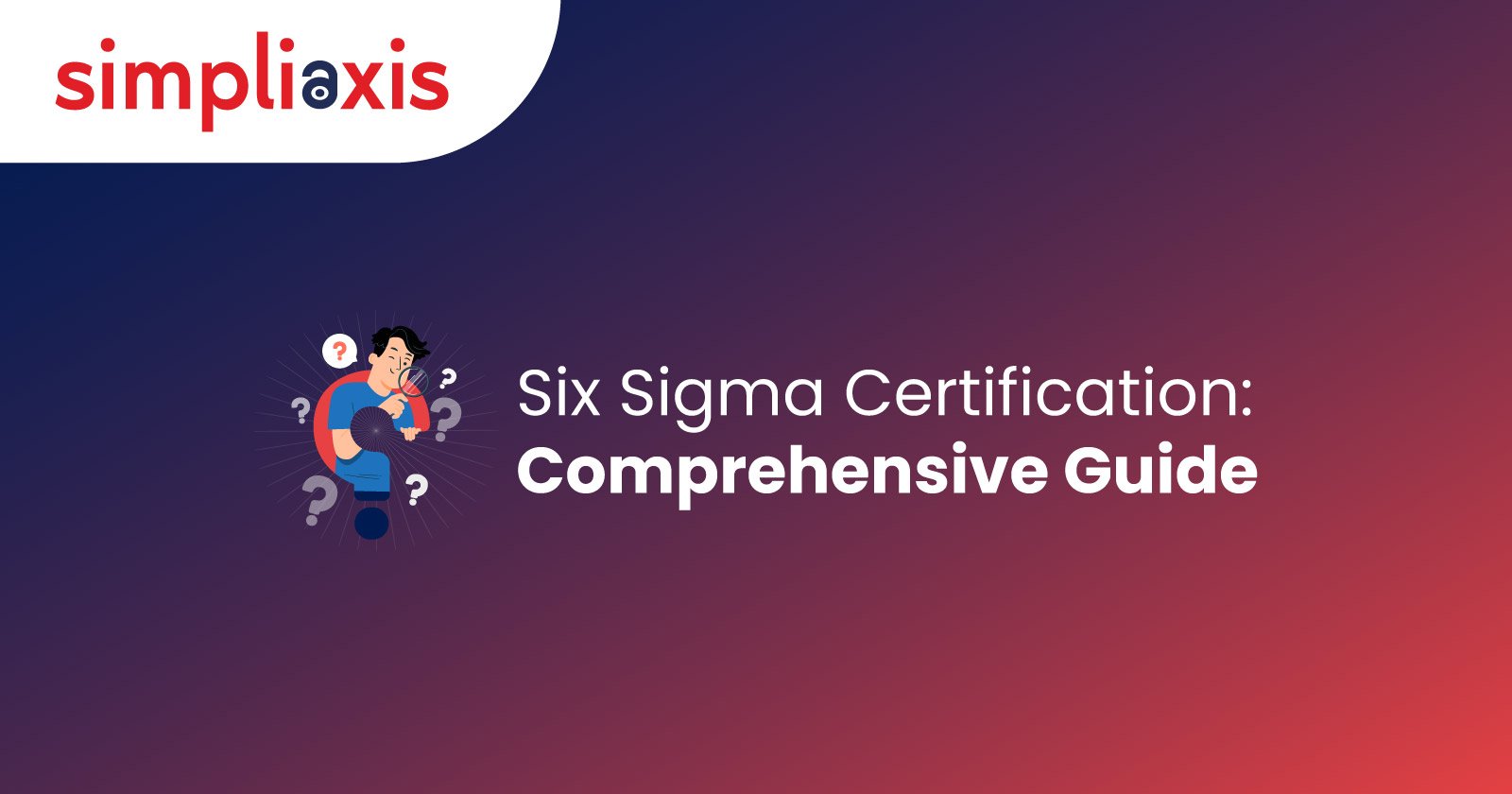Introduction :-
Lean Six Sigma certification stands as a symbol of excellence, offering professionals a pathway to enhance their skill sets and add value to their resumes. Unlike traditional certifications, Six Sigma provides a complete set of process management tools highly respected by businesses worldwide for their effectiveness in increasing operational efficiency and reducing defects.
Businesses striving for excellence turn to Six Sigma, a methodology that empowers them to achieve unrivaled quality and performance. In today's fast-paced world, keeping up with Six Sigma certification is no longer just beneficial - it's critical.
This article will discuss the complexity of Lean Six Sigma certification training and explore the numerous tools and techniques designed to foster continuous improvement. Whether you are a seasoned professional or new to quality management, this will guide you and provide the knowledge required to confidently navigate the certification landscape, helping you make informed decisions on your journey toward process excellence.
What is Lean Six Sigma Certification?
Six Sigma certification is a professional credential that validates an individual's expertise and proficiency in the principles and practices of Six Sigma methodology. Six Sigma is a data-driven approach to process improvement that aims to minimize defects or errors in products or services by identifying and eliminating variations in processes. It originated in the manufacturing industry but has since been widely adopted across various sectors, including healthcare, finance, and service industries.
The certification typically involves rigorous training and examination of concepts such as DMAIC (Define, Measure, Analyze, Improve, Control), statistical analysis, process mapping, and other tools and techniques used in Six Sigma projects. There are different levels of Six Sigma certification, including Yellow Belt, Green Belt, Black Belt, and Master Black Belt. Obtaining Six Sigma certification can enhance career prospects, as it demonstrates an individual's ability to drive process improvement and achieve tangible results within an organization.
Let’s understand the difference between Six Sigma & Lean Six Sigma with the help of the illustration below.
LEAN
prioritizes efficiency by actively minimizing waste, errors, and delays.
Six Sigma
Enhance quality and uniformity by reducing variance and streamlining processes.
LEAN SIX SIGMA
uses quality standards and effective operations to deliver value to the customer.
Benefits of Choosing the Six Sigma Certification
Here are the top 5 benefits of Six Sigma certification training, each with an explanation:
1. Enhanced Skills: Six Sigma training provides individuals with a comprehensive set of tools and methodologies for process improvement. Through rigorous coursework and practical exercises, participants develop proficiency in statistical analysis, problem-solving techniques, and project management skills. This enhanced skill set empowers individuals to identify inefficiencies, reduce defects, and drive continuous improvement within their organizations.
2. Career Advancement: Holding a Six Sigma certification significantly enhances career prospects. Employers value professionals who possess specialized skills in process improvement and quality management, as they contribute to the organization's bottom line by optimizing processes and delivering tangible results. With a Six Sigma certification, individuals stand out in the job market and are often considered for leadership roles and higher-level positions.
3. Increased Efficiency: Six Sigma methodologies are focused on eliminating waste, reducing variation, and optimizing processes. By applying Six Sigma principles, organizations can streamline operations, improve productivity, and enhance efficiency. Certified professionals play a key role in driving these efficiency gains by leading process improvement initiatives, implementing best practices, and fostering a culture of continuous improvement throughout the organization.
4. Quality Improvement: Six Sigma is synonymous with quality improvement. By reducing defects and minimizing variation in processes, organizations can deliver products and services that consistently meet or exceed customer expectations. Certified Six Sigma professionals are trained to identify root causes of quality issues, implement corrective actions, and monitor process performance to ensure sustained improvement over time. This focus on quality not only enhances customer satisfaction but also strengthens the organization's reputation and competitiveness in the market.
5. Organizational Impact: Six Sigma certification training goes beyond individual skill development; it has a broader organizational impact. Certified professionals serve as change agents within their organizations, driving cultural transformation and promoting a mindset of continuous improvement. By championing Six Sigma initiatives, individuals can align business goals with customer needs, optimize resource allocation, and drive strategic growth. This organizational impact extends beyond individual projects and contributes to the long-term success and sustainability of the business.
Importance of Getting Lean Six Sigma Certification
- Enhanced Problem-Solving Skills: Lean Six Sigma methodologies provide a structured approach to problem-solving, equipping professionals with the tools and techniques to identify, analyze, and solve complex business problems effectively. This skill set is invaluable across various industries and roles.
- Increased Efficiency and Productivity: By applying Lean Six Sigma principles, professionals learn how to streamline processes, eliminate waste, and optimize workflows. This leads to improved efficiency, reduced cycle times, and increased productivity within organizations, ultimately contributing to bottom-line results.
- Quality Improvement: Lean Six Sigma emphasizes a commitment to quality by minimizing defects and errors in products or services. Professionals with Lean Six Sigma certification are equipped to lead quality improvement initiatives, ensuring that organizations deliver high-quality offerings that meet customer expectations.
- Cost Reduction: One of the core goals of Lean Six Sigma is to identify and eliminate unnecessary costs within processes. By reducing waste and inefficiencies, organizations can realize significant cost savings, leading to improved profitability and competitiveness in the marketplace.
- Career Advancement Opportunities: Having a Lean Six Sigma certification enhances a professional's credentials and demonstrates their commitment to continuous improvement and excellence. This can open up new career opportunities, increase earning potential, and position individuals as valuable assets within their organizations or in the job market.
- Cross-Industry Applicability:Lean Six Sigma principles are not limited to specific industries or sectors. Professionals with this certification can apply their skills and knowledge across a wide range of fields, including manufacturing, healthcare, finance, IT, and more, making them versatile and in-demand professionals.
- Leadership Development: Lean Six Sigma training often includes leadership and change management components, allowing professionals to develop skills in project management, team leadership, and stakeholder communication. These leadership skills are transferable and highly valued in managerial and executive roles.
Levels of the Six Sigma Certification
Six Sigma is a set of techniques and tools for process improvement, and it is structured across several levels of certification, each represented by a colored belt, similar to martial arts. Here are the different levels of the Lean Six Sigma Certification:
White Belt: The White Belt level provides an introduction to the basic concepts, principles, and terminology of Six Sigma. It is often a brief overview of the methodology and its applications within organizations. White Belt training is suitable for individuals who are new to Six Sigma or those who require a foundational understanding of the principles.
Yellow Belt: Yellow Belt training delves deeper into the fundamental concepts of Six Sigma, focusing on techniques such as DMAIC (Define, Measure, Analyze, Improve, Control) and basic problem-solving tools. Yellow Belts typically support Six Sigma projects within their respective teams or departments and contribute to process improvement efforts under the guidance of higher-level practitioners.
Green Belt: Green Belt training is more comprehensive and involves a deeper understanding of Six Sigma methodologies, tools, and techniques. Green Belts are capable of leading smaller-scale improvement projects within their organizations, applying statistical analysis to identify root causes of problems, and implementing solutions to achieve measurable results.
Black Belt: Black Belt certification is the most advanced level of Six Sigma certification and entails a thorough mastery of the methodology, statistical analysis, and project management skills. Black Belts lead large-scale improvement projects, mentor Green Belts, and play a significant role in driving organizational change and achieving strategic objectives. They are proficient in advanced statistical tools and have a deep understanding of process optimization principles.
Master Black Belt: Master Black Belt certification represents the highest level of expertise in Six Sigma. Master Black Belts are seasoned professionals who provide leadership, guidance, and mentorship to Black Belts and Green Belts across multiple projects and throughout the organization. They often work closely with senior management to develop Six Sigma strategies and drive continuous improvement initiatives at the highest level.
Also Check:5s in Six sigma
Tools & Techniques learned in Lean Six Sigma Certification
Lean Six Sigma certification equips individuals with a variety of tools and techniques to identify, analyze, and solve problems, as well as to drive process improvement initiatives within organizations. Some of the key tools and techniques commonly learned in Lean Six Sigma training include:
- DMAIC methodology
- SIPOC analysis
- Process mapping
- Root cause analysis (fishbone diagrams, 5 Whys)
- Statistical analysis tools (histograms, Pareto charts, control charts, regression analysis, hypothesis testing, DOE)
- Kaizen events
- 5S methodology
Step-by-Step Process to Achieve Six Sigma Certification
The journey to attain Six Sigma certification involves a well-defined process that reflects dedication and a commitment to mastering the principles of quality improvement. Here are the key steps to guide you on the path to achieving Six Sigma certification:
Understand Six Sigma: Gain a basic understanding of Six Sigma principles and methodologies, focusing on its core concepts of reducing defects and variability in processes.
Select Certification Level: Choose the certification level that best suits your career goals and current knowledge level, such as Yellow Belt, Green Belt, or Black Belt.
Enroll in Training: Enroll in a Six Sigma training program accredited by IASSC and complete your training with recognized organizations like Simpliaxis, which covers the necessary curriculum for your chosen certification level.
Complete Training Requirements: Fulfill all the training requirements, including attending online classes, completing coursework, and passing any required assessments or exams.
Pass Certification Exam: Prepare for and pass the certification exam to demonstrate your understanding of Six Sigma principles, methodologies, and tools.
Apply Six Sigma Principles: Utilize your certification to drive process improvements, reduce defects, and optimize performance in your organization or projects, applying Six Sigma principles in real-world scenarios to deliver tangible results.
Conclusion
Obtaining Six Sigma certification is a significant step towards mastering process improvement methodologies and enhancing one's career prospects in quality management and project leadership. This comprehensive guide has outlined the essential steps involved in achieving Six Sigma certification, from understanding the principles of Six Sigma to applying them in real-world scenarios. By selecting the appropriate certification level, enrolling in accredited training programs like Six Sigma Fundamentals training, and passing certification exams, individuals can demonstrate their proficiency in Six Sigma methodologies and contribute to organizational success through continuous improvement initiatives. With a solid foundation in Six Sigma principles and practical experience in process optimization, certified professionals are well-equipped to drive operational excellence, reduce defects, and deliver measurable results in today's competitive business environment.
















